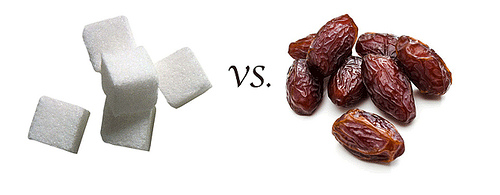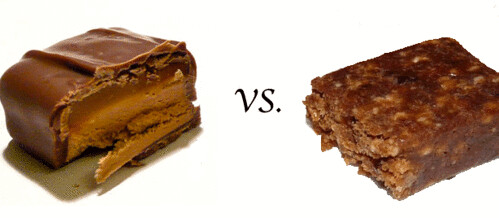- ニュース
Aren’t Dates Just Sugar?

Fruit and nut bars are proving very popular these days. It all began with the Larabar, which was swiftly followed by the Nakd bars, and now our Raw Bite bars. Yes, they are made with just fruit and nuts but then we got to thinking, is the sweetness of a date any different to the sweetness of sugar and if not, is this really any different to eating a candy bar? If you take a look at the GI scale dates are high up there, not far behind sucrose (though this does depend on the type of date – deglet being higher than medjool). This would mean that a ‘healthy’ Larabar would give you just as much of a sugar rush as a candy bar, wouldn’t it?
We put this question to the makers of our Raw Bite bars and got this very interesting response:
Our claim regarding stable blood sugar is based on theoretical calculations and practical experience.
Based on theoretical data, we have calculated the glycemic load (GL) of each Rawbite. When assessing the influence of a food on blood sugar levels, GL is a more accurate approach than the glycemic index (GI). That is because it also takes into account the actual content of carbohydrate in the food. For example dates have a very high GI, but when combined with other food with very low GI and low carbohydrate content (like nuts), you get a much lower influence on blood sugar than the GI originally predicts. You can read more about GL her: http://en.wikipedia.org/wiki/Glycemic_loadA food with a GL<10 is low, GL=10-19 is moderate, GL>20 is high. Food with GL<20 is recommended, if one wants to avoid spikes in blood sugar. GL is a highly recommended tool when dealing with metabolic syndromes, like type 2 diabetes.The calculated GL of the different Rawbites based on the percentage of ingredients is in the range 10-12, which is low-moderate. So in theory Rawbites do not create significant spikes in blood sugar levels, while still providing carbohydrates, and can therefore be considered a food that provides a stable blood sugar.There is an establish methodology for calculating GL and we have used it for the Rawbites.For example:A rawbite cashew has 26 g of dates and 24 g of cashews. The GI of dates is according to different sources on average 40 and cashew is 3.The methodology for calculating GL is:GL = mass of food in gram x GI of food per 100 gramGL = 26 x 40/100 + 24 x 3/100 = 11,1
Current thinking seems to be that it is not the GI of the food that is important but the Glycemic Load or GL. Even a high GI food isn’t too bad if the proportion of carbohydates in that food is low. A good example given on this site is of a watermelon. Watermelon has a high GI but because it is mostly water with very few carbohydrates in it, when you eat it the amount it raises your blood sugar is relatively low. The same is true, says the makers of Raw Bite, of their bars. The dates are high GI but because they are combined with low GI cashews the total GL isn’t so bad. You need to look at the final food, not the individual ingredients, so the picture we should be making is this:
Predictably the story is a lot more complicated than it first appears to be. You can’t rate a food as good or bad based on it’s GI but instead have to think of the food you are eating as a whole. This highlights once again how important it is to eat a well balanced and varied diet. It isn’t just the individual foods you eat but how you combine them that affects how your body uses the nutrients they contain. Dates are high GI and eating only dates is probably not too much better than eating sucrose. However, mix them up with some nuts or oats and suddenly you have a food that is much healthier for you and doesn’t send your blood sugar through the roof. S0 we can proudly stand behind our fruit and nut bars and say they *are* a healthy food.







